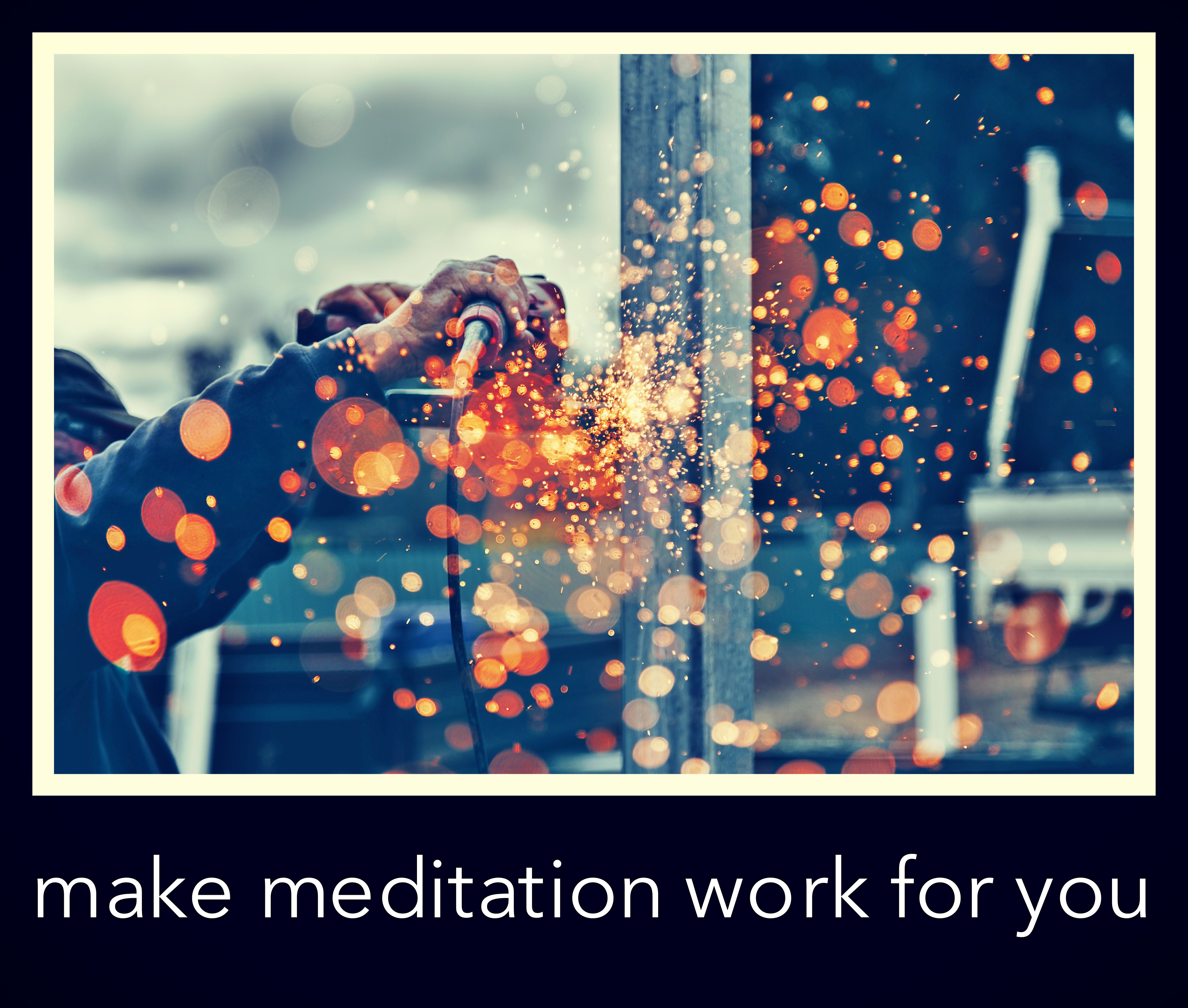💝 Making Mindfulness Meditation Work For You – Part 1 💝
In the Buddhist traditions not only is meditation taught but ethical and moral teachings as well. Why? Because if you ain’t livin’ right meditation ain’t gonna do you much good. Buddhism offers a complete teaching that prepares the student’s mind that include most known The Four Noble Truths, The Eightfold Path, The Five Precepts and The Three Jewels. There are others but these are the core teachings. I will be getting into these and others down the line and you will be able to see how it all works together.
There is a real possibility to get lost in meditative states and lose focus. In this previous essay, Creative Problem Solving Through Meditation, I spoke of the power of non-attachment. Without proper guidance the process of non-attachment can be taken too far where you lose regard for yourself and others and that can take one down a dark path. We have all heard about gurus that have been less than scrupulous and devotees getting lost in a cult like dream. This is why the scientific approach to meditation/sitting and ethical teaching is so important. Dr. Itai Ivtzan wrote for Psychology Today and says:
However, such non-attachment does not mean avoiding, repressing or disregarding anything. We should not detach ourselves from the people and activities we love and enjoy, nor should we become passive or inactive. Non-attachment simply changes the quality of the relationship with life: it allows you to make conscious and peaceful choices, because you relate to people, events and yourself, in a non-attached manner. March 11, 2016
What is the purpose of all of this? Transformation and rise above our primal animalistic selfish and negative tendencies. We all have them because they help our species survive. But they don’t contribute to a better world or a better self. So here we go!
The Four Noble Truths
- the truth of suffering
- the truth of the cause of suffering
- the truth of the end of suffering
- the truth of the path that leads to the end of suffering.
More simply put that suffering exists and it has a cause. But that it also has an end and it has a solution to bring about its end.
The Truth of Suffering and it’s Cause
One of the features of our brains that helped our species survived is the negativity bias. Ever felt negative for no apparent reason at all? The negativity bias may be at work. Dr. Rick Hanson who is a psychologist and Buddhist teacher with a specialty in neuroscience wrote about the negativity bias in a post titled Confronting the Negativity Bias. Here is a snippet that explains how it developed and also why you may be easily intimidated:
The nervous system has been evolving for 600 million years, from ancient jellyfish to modern humans. Our ancestors had to make a critical decision many times a day: approach a reward or avoid a hazard — pursue a carrot or duck a stick.
Both are important.
Imagine being a hominid in Africa a million years ago, living in a small band. To pass on your genes, you’ve got to find food, have sex, and cooperate with others to help the band’s children (particularly yours) to have children of their own: these are big carrots in the Serengeti. Additionally, you’ve got to hide from predators, steer clear of Alpha males and females looking for trouble, and not let other hunter-gatherer bands kill you: these are significant sticks.
But here’s the key difference between carrots and sticks. If you miss out on a carrot today, you’ll have a chance at more carrots tomorrow. But if you fail to avoid a stick today – WHAP! – no more carrots forever. Compared to carrots, sticks usually have more urgency and impact.*
Many people know that compassion is a core tenet of Buddhism. But a lot of people are surprised to find out that the that the first part of compassion is compassion for yourself.
I highly suggest you read the entire post he offers brilliant explanations of how our minds work and why that will immediately leave you with a feeling of self compassion! Here I will do my best to explain as I understand it. According to Dr. Hanson from an online seminar I participated in I paraphrase forthright.
The brain to protect you operates in the following manner:
- Scan for bad news
- Over focus upon it
- Overreact to the stimulus
- That whole package gets sucked into internal body memory (one bitten twice shy)
The stress hormone cortisol then goes into the brain and over sensitizes the amygdala. This becomes a vicious cycle – positive experiences pour through us like going through a sieve while the negative experiences stick to us like
Great way to keep alive in the stone age or in a combat zone or if your life is at risk as a child but creates unnecessary conflict as adults within the groups we interact with. Thus moving towards the positive while releasing the negative in pain the process rather than suppressing it helps our brain.
The enjoyableness of an experience usually indicates the value of an activity so leaning into beneficial experiences is beneficial to the brain. We need to tilt towards the positive to counteract the negativity bias. Obviously I’m not talking about overdoing something that initially feels good…we all know what happens. It ends up feeling bad.
To sum this up the negativity bias it is a feedback loop.

Photo by Zac Durant on Unsplash
Gratitude on the Path to the End of Suffering
Gratitude is an excellent way to counter the negativity bias. It is not easy if you are not taught what you are dealing with and how to counter it. Do you have ANY experiences or activities that you feel naturally grateful for? There is no shame in finding gratitude difficult. With a bit of practice you can become a pro at it. If you want to be more grateful have more experiences of gratitude, it’s quite that simple. If you want to be more anything have more of those type of experiences.
One step in that direction is to be for yourself as opposed to against others. Self-compassion! Meditate and drink in the teachings because you are about you. That is always the first step. We do not embark on the journey of contemplative transformation to become a doormat. We move from selfishness to self-regard and self-love through this process and that is the only way we can truly then feel compassion for others. Not the other way around.
Very important to fill yourself up with the quality of being your own ally or advocate of your own well being. Compassion – empathic sensitivity to a being’s suffering AND being moved to do something about it means you take action for your healing and shall we say…enlightenment? Through sympathy and warm heartedness lean toward helpfulness toward the being that is suffering, yourself.

Photo by Priscilla Du Preez on Unsplash
Here is an exercise Dr. Hanson taught us:
Step 1) Bring to mind beings who care about you Give yourself the experience so you feel it in your body. Helping yourself to feel cared about.
Step 2) Bring to mind being or beings that YOU care about. Ground and anchor yourself with a sense of felt compassion
Step 3) Apply that compassion to yourself. Loss, pain or unfulfilled longings. Supportive care and concern for you. Nurturing and supportive. Get a felt sense of it sinking down into you and sifting down and touching places deep inside that have been wounded. The brain doesn’t differentiate positive experiences so that is how it works. Sinking in is the method of positive neuroplasticity
Through this process you are releasing shame. Moving forward look for the opportunities over a course of a day that are REAL where you were capable, skillful or generous where you saw the good or divine spark in another. GIVE THAT EXPERIENCE A BREATH AND LET IT SINK IN FOR POSITIVE NEUROPLASTICITY.

Photo by Giulia Bertelli on Unsplash
One Last Word on Self-Compassion
Be aware of the old saying fences make for good neighbors which is equivalent to healthy boundaries. Really tune into your own body. Get a sense of allies who are with you, friends and buddies for when you have to deal with people that are difficult. I wrote about boundaries in this essay Emotional Blackmail: Welcome to the Dark Side.
Difficult people are suffering and have needs that are not being met. They say that hose who do know settle their quarrels because they know someday I die. But the being I have the most power over is myself, I’m gonna take care of me because the person I have the most responsibility to is ---- my future self.
And a note about women and caretaking. Women are socialized to be FOR OTHERS but not for themselves. You don’t have to teach a dog or a lizard or a squirrel to be for themselves it is natural. Check inside to see how you are feeling in general – overwhelm? Also if you notice you are getting upset stop for your own suffering. Be a friend to yourself and don’t dismiss your own pain like others may have perhaps when you were growing up. Accept it and honor it like oh wow, oh ooooh, ok I see you, I feel you, I am going to take care of you. Then make a plan. Watch and observe for the next 60 seconds and don’t pour gasoline on it.There is a radiant true nature that is always present and we have felt it in those special moments in our lives that transcend time whether being in love, holding an infant, etc. It’s always available to us it just takes a bit of effort. With this type of knowledge informing your meditation and sitting you become unstoppable.
What do you think?
Dr. Rick Hanson has a free weekly e-newsletter, Just One Thing, offering a simple practices taking only a few minutes to help you feel greater happiness, wisdom, and love. Also, a YouTube channel, with interviews, talks, and guided experiential practices. He is the author of Buddha's Brain and Hardwiring Happiness.
Recent Posts
Creative Problem Solving Through Meditation

@soulsistashakti is a musical artist and writer based in NYC as well as a practitioner of Buddhist teachings. You can check out my music on my FB artist page at https://www.facebook.com/soulsistashakti



With meditation we know ourself and come to close our soul.
thank you for your input :)
I like your approach to things. It's like meditation at its best leads to non-attachment -- in the sense of non-attachment to outcomes while remaining attached to the process. In other words, love others but do not punish or hate them for being who they are. Love your job and do it well but don't worry about the end result; if you "do it well", the end result will be positive in an emergent manner.
Very nice interpretation thank you for sharing it with us :)